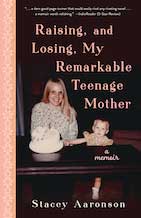When I was doing research on comparable books to mine that I could list for librarians, I exhaustedly hit a wall: practically every mother-daughter memoir, on every list I found, was centered on dysfunction. Even novels in the genre seemed to have a ribbon of discontent between mothers and their female offspring running through them.
“All the stories are about problematic mother-daughter relationships,” I lamented to my marketing partner.
She laughed. “That’s because most of them are! Yours was definitely not the norm.”
I knew this, of course. The word “unconventional” had defined my relationship with my mom in pretty much every way since day one; all my life, people had marveled at the rare, quirky, playful bond my mom and I shared. But after discovering that virtually no one—at least not that I could find—had written about their (mostly) functional relationship with their mom, I was especially grateful that I’d penned the decidedly wacky and wonderful story of ours.
After all, we’d been fostering our distinct Gilmore Girls–style us-ness for five decades, ever since I popped out of her womb when she was a bubble-haired, just-out-of-braces sixteen-year-old.
In our earliest days together, my mom basically viewed me as a live baby doll she could dress in cute outfits with matching booties. Beyond that, she wasn’t quite sure what to do with me. (Enormous kudos to my adoring grandparents and exceedingly mature twenty-year-old dad who filled in the gaps!) But by the time I was two and verbal enough for my mom to engage me in conversation, our open chats became a cornerstone of our relationship. Not the norm for a toddler, I know. My mom not only loved sharing things with me, she was genuinely interested in my opinions.
For someone who admitted she was “sixteen in body but more like twelve in mind,” and who entirely rejected mothering cues from her mostly structured, mid-century upbringing, my mom was already instilling in me that my voice mattered.
Having been adopted, my mom was elated to finally have a biological connection, and I became her instant playmate—well, sort of. The thing was, I had come here (in her words) as the “wiser, more mature one” of the two of us, which meant it didn’t take long for frequent role-reversal to occur in our relationship.
The following example will give you a taste.
Her (with a dejected face): “Pleeease don’t go to school today.”
Me: “What? I have to.”
Her: “No, you don’t.”
Me: “Yes, I do.”
Her: “But I want you to stay home and play with me.”
Me: “I can’t stay home and play with you. I have school. And I want to go.”
Her (further deflated): “But I won’t have anyone to play with.”
Me (matter-of-factly): “Well, you’re just going to have to find something to do.”
The antics on my mom’s end sometimes knew no bounds. And though my response was at times squinty-eyed scrutiny, or a hand thrown on my hip when I’d gotten her number on some joke she’d played on me, there were also plenty of days spent dancing around together and singing to our favorite artists from the mid-’70s, or her watching me frolic in our local park, or taking long, chatty walks hand in hand in a little haven of our SoCal neighborhood akin to a mini Naples, Italy.
As we grew up together, one of the greatest gifts I received from my mom was her allowing me to, as she coined, “dance to my own drummer.” While we shared an uncommon compatibility and adoration of each other, as well as naturally upbeat personalities, we were also very different. Yet my mom never strove to reshape me into someone who reflected her more nonconformist sensibilities; instead, she bestowed unparalleled freedom on me to blossom in my own particular soil, idiosyncrasies and all, with complete acceptance of who I was.
Though I spent my teen years living with my dad, and it was undoubtedly heartbreaking at times for my mom and me to see each other only sporadically, we came back together under the same roof when I was an adult. After nine years apart, we delighted in having independent lives yet relishing when we could spend time watching favorite movies, playing endless games of gin, and cultivating our signature witty banter. When she resolved to seek out her birth mother, I was by her side; when I ended an ill-fated engagement and decided to go to college at age twenty-five, she was by mine. When we needed a confidant to share heartaches and dreams, disappointments and joys, I was there for her as much as she was there for me.
And when my beautiful mom—with whom I had always treasured exchanging mother and daughter roles throughout our souls’ journey together in this lifetime, and whose unconditional love for me had never once wavered—left this Earthly plane much earlier than I ever expected, I was there as she set off for her next grand adventure.
Like the affecting Seals & Crofts song, “We May Never Pass This Way (Again),” it saddens me to think that who we’ve been together this past half century is over, but I also know that soul mates like us will never truly be apart.
 The product of an exceptionally loving, accepting, and big-hearted family, Stacey Aaronson is author of the memoir Raising, and Losing, My Remarkable Teenage Mother. She is also founder of The Book Doctor Is In, where she takes writers by the hand as a ghostwriter, editor, book and website designer, and publishing partner to bring books of excellence to life. To date, she has been gleefully and gratefully involved in the full or partial production of over two hundred books, both within her business and as a layout artist for She Writes Press. Stacey lives with her soul mate of twenty-one years, Dana, and their rescued Maine Coon kitty. Visit Stacey at www.thebookdoctorisin.com and www.staceyaaronson.com.
The product of an exceptionally loving, accepting, and big-hearted family, Stacey Aaronson is author of the memoir Raising, and Losing, My Remarkable Teenage Mother. She is also founder of The Book Doctor Is In, where she takes writers by the hand as a ghostwriter, editor, book and website designer, and publishing partner to bring books of excellence to life. To date, she has been gleefully and gratefully involved in the full or partial production of over two hundred books, both within her business and as a layout artist for She Writes Press. Stacey lives with her soul mate of twenty-one years, Dana, and their rescued Maine Coon kitty. Visit Stacey at www.thebookdoctorisin.com and www.staceyaaronson.com.




















